Excerpts from Jim Conrad's
Naturalist Newsletter
Entry dated July 12, 2023, issued from near Tequisquiapan, elevation about 1,900m (6200 ft), N20.565°, W99.890°, Querétaro state, MÉXICO
(~N20.57°, ~W99.89°)
"CENTURY PLANT"/"MAGUEY"
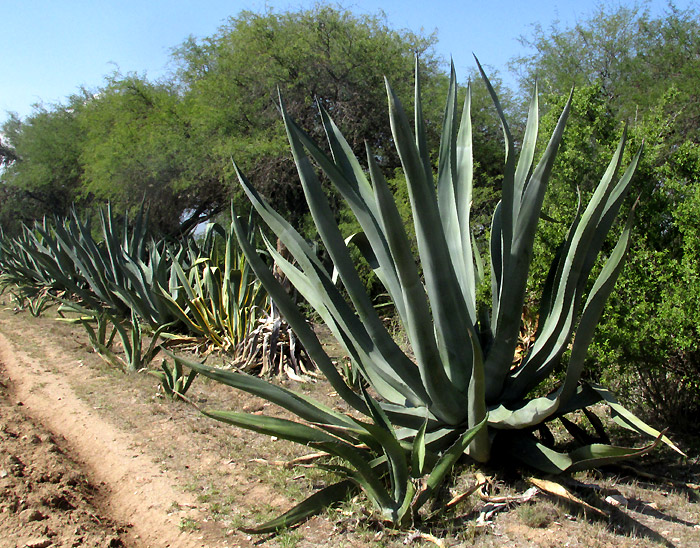
In this area the above view is very typical. The picture shows one of several giant agave plants which are native to this area, as well as much cultivated. Often you can't decide whether you're seeing free-growing or cultivated plants. In English, all of them variously are called Century Plants, Giant Agaves, Pulque Agaves, Magueys, and other names. The above is AGAVE AMERICANA, which can be compared with the commonly seen and similarly multi-named Agave atrovirens and Agave salmiana. My impression is that in the surrounding mountains Agave salmiana is the most commonly encountered, while here in the altiplano plains below the mountains Agave americana most often is seen.
In the above picture, the nearest plant stands about 2.4m tall (8ft). On the left of the tall plant, notice the smaller one with blades displaying yellow margins. Here's a close-up:
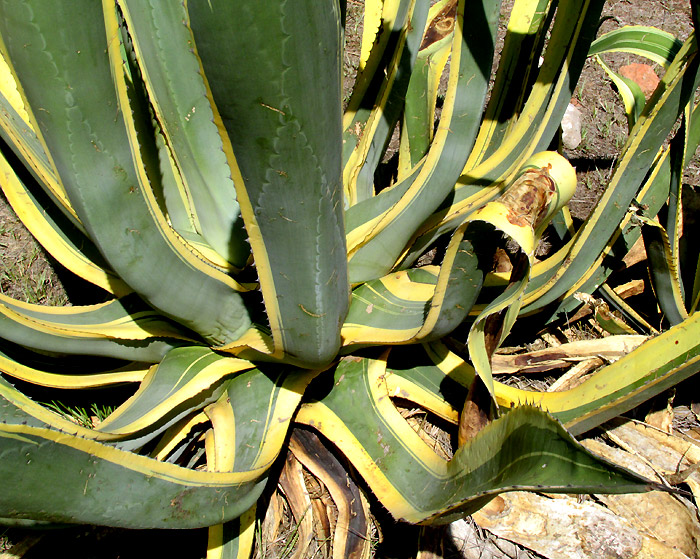
That's an ornamental variety, "marginata," and occasionally you see it cultivated as a typical Agave americana, as well as grown ornamentally in local villages. It seems to be somewhat smaller than the typical form, with its blades narrower at the base. Here's a similar picture to the above, showing typical Agave americana leaf bases:
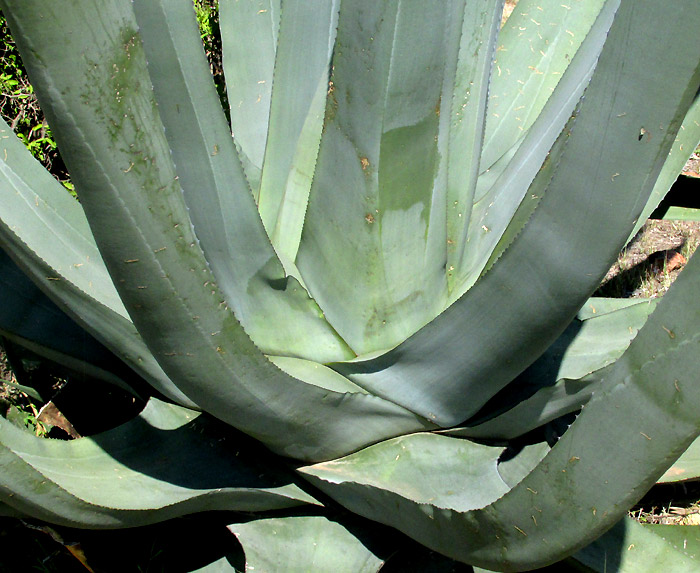
Notice how the leaf bases are somewhat concave. The plant's blades are appreciated by wildlife because they do this after rains:
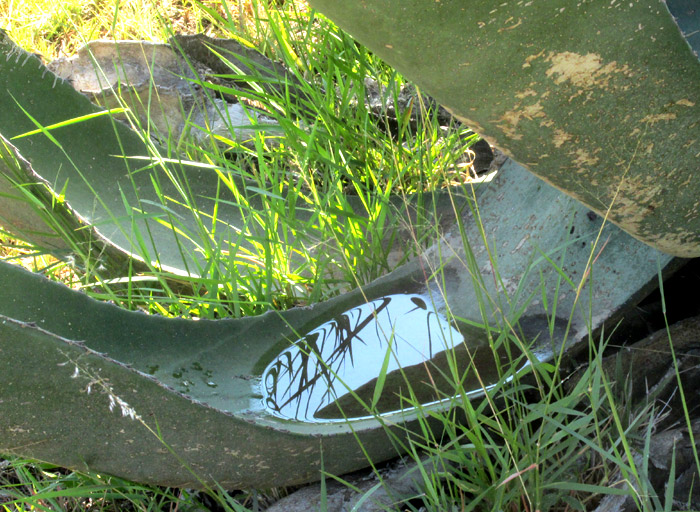
Normally Agave americana lives 10-30 years before it flowers, then immediately it dies. However, around the plant's base, usually there are sprouts, or pups, who replace the dead plant.
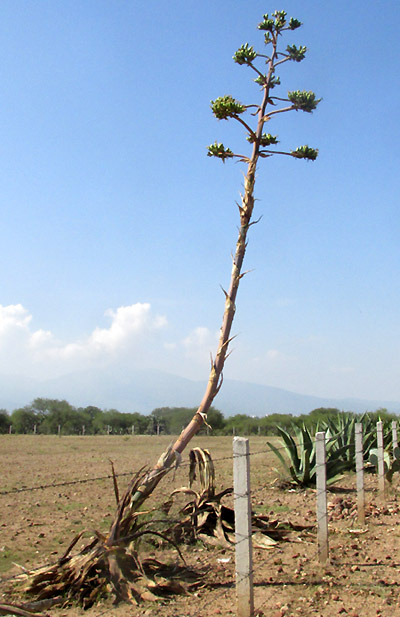
Inflorescences of Agave americana reach 8-9 meters tall (25-30ft), though the above one is somewhat shorter, and its fruiting structure less developed than often is the case. Probably that's because it's in a very dry spot growing in soil that's been depleted and compacted by many years of overgrazing and sheet erosion. That's one of the attractions of Agave americana, however: It survives and produces services where other plants can't.
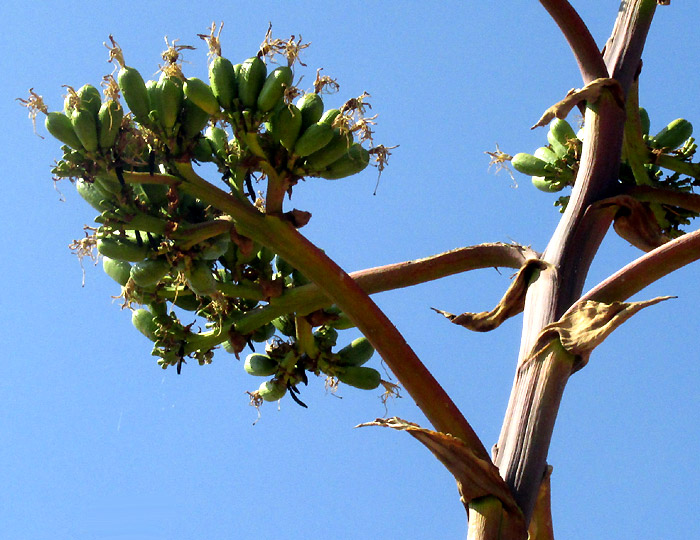
The above close-up shows immature fruits with flower parts still attached to their tops. Note the substantial, sharp-pointed bracts subtending each inflorescence branch. Bracts vary from species to species in size, texture and permanence.
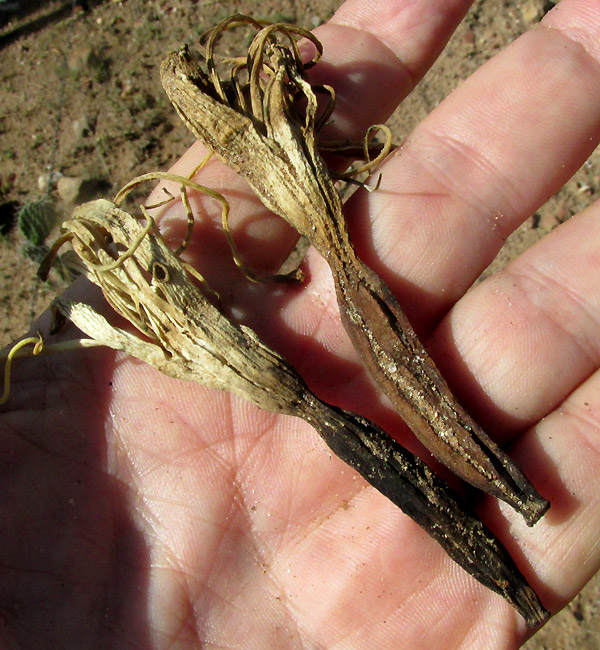
Identification of giant agaves often relies on flower size. The above fallen and somewhat shrunken ones are about 9cm long (3.5inch).
Agave americana is native to Mexico, including this upland, central part, and the Flora of North America regards it as native to southern Texas and southern Arizona, as well. Though the species was named by Linnaeus in 1753, based on material originally form Mexico, the species' genetic history is complex and not well understood. Two subspecies are recognized, as well as four or so varieties, and several cultivars besides the above 'Marginata.' The Flora of North America regards Agave americana as "... most certainly a polyploid complex based on x = 30, with reports of n = 30 and 2n = 60, 120, and 180..."
Nowadays Agave americana is cultivated in many countries worldwide. It's uses include that of the production of aguamiel, or sap, which ferments to form the important traditional alcoholic drink called pulque. Pulque can be distilled to make the high-alcohol mezcal. Fibers for making ropes, nets, bags, matting, and a coarse cloth can be taken from the leaves. Medicinally, it's been used to treat numerous ailments, though there's little or no lab work supporting its effectiveness. In our area, the leaves are cut with a machete into pieces and fed to cattle. There's more on its edibility below.
entry from November 16, 2021, issued from near Tequisquiapan, elevation about 1,900m (6200 ft), N20.565°, W99.890°, Querétaro state, MÉXICO
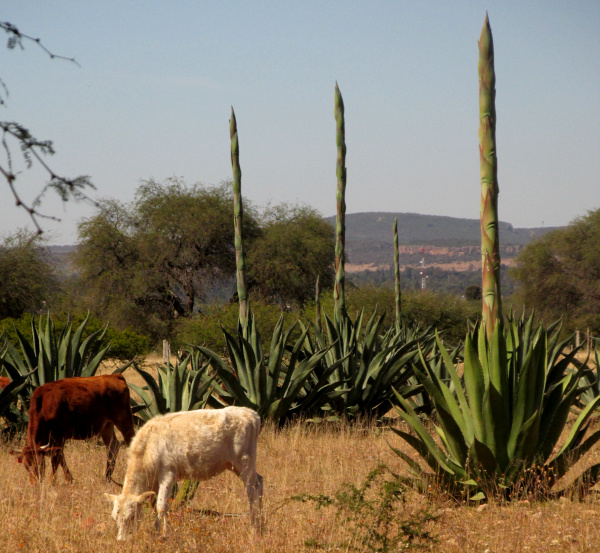
MAGUEYS SPROUTING FLOWERING HEADS
Nowadays many Maguey plants in the area are sprouting tall, asparagus-type shoots that will open into flowering heads, or inflorescences. Both Asparagus plants and Maguey are currently assigned to the Asparagus Family, the Asparagaceae, so the resemblance isn't incidental. In some places the flowering heads reach 12m tall (40ft), but I'm not sure that at these cool elevations they get so tall.
Normally Magueys live from 10 to 30 years, then the big rosette dies after it's flowered and fruited. However, usually sprouts at the rosette's base grow into new plants.
from the January 19, 2007 Newsletter issued from Sierra Gorda Biosphere Reserve, QUERÉTARO, MÉXICO
SWEET MAGUEY HEART
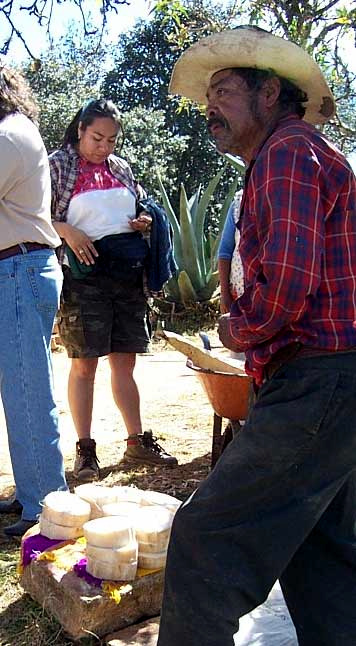
Passage to and from the lookout point took us through a maguey plantation. Remember that magueys are any of several agaves from which the alcoholic pulque, mezcal and tequila drinks are made. On our return trip a fellow was waiting for us with sweet slices of maguey heart, as shown above with a small maguey in the background.
When you want to make pulque or the other drinks you begin by cutting away a maguey's heart so that a hole is formed where the center leaves arose. The maguey's sweet sap slowly fills the hole, then is removed and fermented. Of course, removing a maguey's heart kills the plant.
The removed spongy pith is full of sweet sap and can be chewed just like sugarcane stems. The picture shows a student digging into her purse to pay ten pesos, about 90 cents, for her slice, and so did several others. The fellow made a few dollars out of us that day. As I followed the students downslope I kept seeing white balls of what looked like chewed-up burlap, which was almost what it was. You take a bite of the pith, chew it until the sweetness is gone, and spit it out. The students loved it.
entry dated July 20, 2022, issued from near Tequisquiapan, elevation about 1,900m (6200 ft), N20.565°, W99.890°, Querétaro state, MÉXICO
A HOLLOWED-OUT MAGUEY
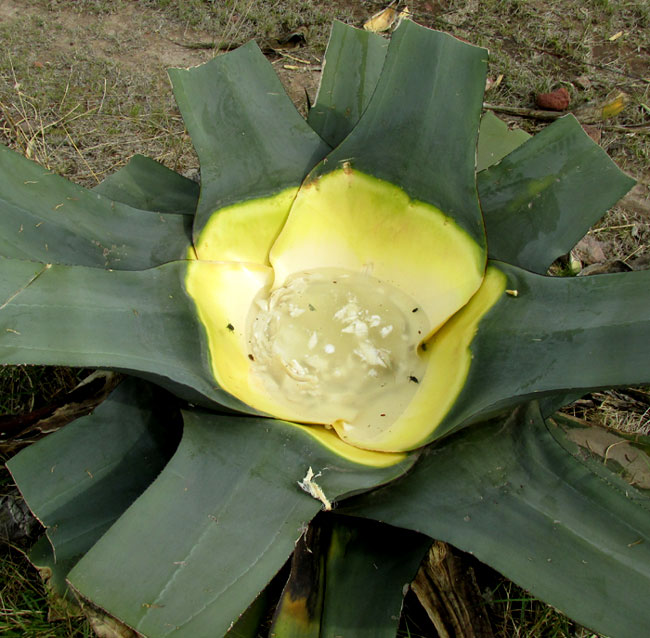
Along a trail through the scrub I encountered a man chopping off the blades of a Maguey I'd passed by nearly daily for most of the last year. I asked him what he was doing, for I'd been told that here people use the big leaves when they roast pigs in pits in the ground. Once a fire has heated up rocks forming the pit's walls and the pig is inside, Maguey blades are placed over the pig to keep the heat in the pit from escaping, and I wanted to confirm that story. But no, he was getting food for his cows. Then I noticed that he'd filled a wheelbarrow behind the ravaged plant with hand-size blocks of Maguey leaf he'd fashioned with his machete.
A couple of days later, the Maguey's center, where the last edible parts had been removed with a machete, was filled with fermenting sap. The sap's surface was bubbly from the fermentation process, and bugs floated on the water. I don't think anyone was trying to make the local fermented drink pulque, which is made just like this, except that the hole in the Maguey's heart is plugged to keep out the animals.
This was just a Maguey bleeding its sap, after receiving a mortal wound on behalf of ever-hungry cows, in the process making one last gift of pulque to anyone who wanted it.
from the Newsletter of June 29, 2007 Newsletter issued from Sierra Gorda Biosphere Reserve, QUERÉTARO, MÉXICO
EATING MAGUEY FLOWERS
This week Don Gonzalo appeared at my door with yet another local delicacy, which you can see below:
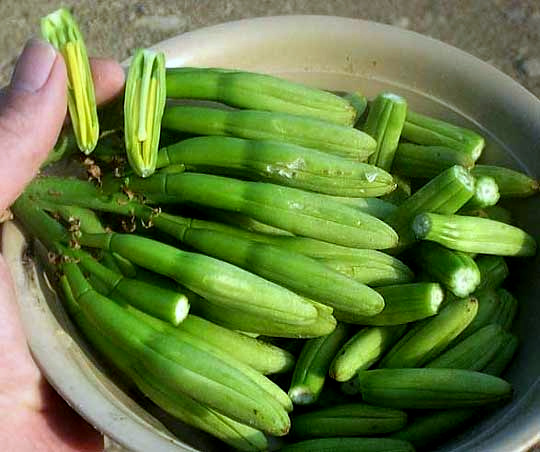
He'd brought immature, unopened maguey flowers, maguey being the giant agave grown here mostly for pulque production, pulque being the local poor-man's fermented drink. In the picture, between my fingers I'm holding a sliced-open blossom inside which you can see one of the six long, yellow anthers full of developing pollen. Just to the right of the flower-half in my fingers is the other flower-half containing a long, slender, pale green, round-ended object, which is the style -- part of the female pistil. On the bowl's left side you see flowers still attached to the branching inflorescence Don Gonzalo macheted from the flower stalk, which can grow up to 40 feet high. The right side of the bowl is filled with blossoms with their bitter bottoms, or ovaries, pinched off.
Don Gonzalo told me how the flowers should be prepared and it sounded pretty good. However, I had no spices so I just dumped them atop eggs frying in my solar oven. Well, simply cooked in a solar oven and eaten alone they're OK but not great, a tad bitter.
A Spanish-language web page on traditional Mexican food-flowers says that Maguey flowers properly cooked have a delicate chicken-like flavor. The flowers make good enchilada and toasted-taco filling, after being baked and lightly salted. They can be sprinkled raw atop certain salads and are tasty in certain soups.